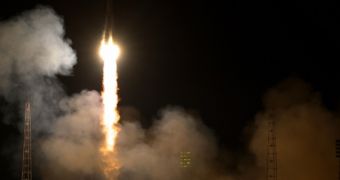Officials at NASA announce that the Soyuz TMA-12M spacecraft carrying three astronauts to the International Space Station (ISS) launched successfully from Kazakhstan earlier today. The capsule was delivered into low-Earth orbit by a Soyuz-FG medium-lift delivery system provided by the Russian Federal Space Agency (RosCosmos).
The Russian-built Soyuz took off from the Baikonur Cosmodrome, in Kazakhstan, at 3:17 am local time earlier today, March 26 (5:17 pm EDT / 2117 GMT on Tuesday, March 25). The three astronauts on board make up the second half of the Expedition 39 crew aboard the space lab. The other three members already in space are all former members of Expedition 38.
Soyuz Commander Alexander Skvortsov (RosCosmos) is joined inside the Soyuz TMA-12M capsule by NASA astronaut Steve Swanson and Oleg Artemyev, also of RosCosmos, who will both act as flight engineers. Already aboard the ISS are Japanese Commander Koichi Wakata, NASA astronaut Richard Mastracchio, and cosmonaut Mikhail Tyurin, from RosCosmos.
The capsule was originally supposed to dock to the Russian-built Poisk module station at around 11:05 pm EDT (0305 GMT) earlier today, less than six hours after launch. Previous missions have all required two days to reach the ISS, but RosCosmos and NASA decided to take an orbital shortcut to reduce the amount of time astronauts have to spend in the cramped confines of the spacecraft.
Reaching the ISS within 6 hours of launch required a series of very precise orbital adjustment maneuvers, both from the station and the Soyuz TMA-12M capsule. During one of the burns the latter conducted earlier today, the necessary orbital parameters were not reached. Russian Mission Control decided to insert the Soyuz into an orbit that would take it safely to the ISS within two days.
“It was later revealed the 24 second burn did not occur, due to an attitude problem with the Soyuz. Russian controllers are still evaluating the root cause of the issue. However, it is understood the Soyuz TMA-12M’s flight computer didn’t command the spacecraft to proper attitude for […] burn, resulting in an automated 'no burn' response,” NASA experts said in a statement released earlier.
The astronaut trio aboard the Soyuz will remain on the ISS until mid-September. They will live and work alongside Wakata, Mastracchio and Tyurin until May 14, when the three crew members already aboard the orbital outpost will climb into their Soyuz TMA-11M spacecraft, and return home. The first half of Expedition 39 arrived in space in November 2013.
Skvortsov, Artemyec and Swanson will then become the first half of the Expedition 40 crew. The second half, made up of Gregory Wiseman (NASA), Maksim Surayev (RosCosmos) and European Space Agency (ESA) astronaut Alexander Gerst, will launch for the ISS aboard the Soyuz TMA-13M capsule on March 25, 2014.

 14 DAY TRIAL //
14 DAY TRIAL //